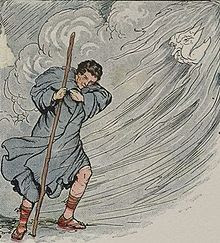This was the main
text I read and referenced when writing my initial proposal. He used the term
animism and personification and I was confused about the difference to
anthropomorphism.
Below are the
definitions I found on Wikipedia.
Animism is the religious worldview that
natural physical entities—including animals, plants, and often even inanimate
objects or phenomena—possess a spiritual essence. Specifically, animism is used
in the anthropology of religion as a term for the
religion of some indigenous tribal peoples,
especially prior to the development and/or infiltration of colonialism
and organized religion.
Anthropomorphism, or personification,
is attribution of human form or
other characteristics to anything other than a human being. Examples include
depicting deities with
human form and ascribing human emotions or
motives to forces of nature, such as
hurricanes or earthquakes. Anthropomorphism
has ancient roots as a literary device in storytelling,
and also in art. Most
cultures have traditional fables with anthropomorphised animals, which
can stand or talk like humans, as characters.
Also on WiseGeek
website they had an interesting explanation of what the difference was.
The difference between anthropomorphism and personification is a subtle one, as each term
refers to a similar assignment of human characteristics to a non-human entity.
Anthropomorphism is a literary device that an author uses to give traditionally
human feelings or actions to an animal, plant, or inanimate object. For
example, the sentence, "The wind blew angrily, expressing the full extent
of his violent rage," applies this concept, because the wind retains its
non-human form while taking on human emotions, intentions, and a masculine
pronoun. Personification works similarly and occurs when the writer allows a
non-human entity to fully embody human traits. The Easter Bunny is an example
of personification, as an animal becomes a total embodiment of human
characteristics and abilities.
Primitive Culture was a very interesting study of primitive
cultures and the common thread of the spiritualisation of inanimate objects.
Mythology, philosophy, religion are all discussed referencing different
cultures. I was also introduced to the term Pareidolia, which is the tendency
to see patterns in abstract phenomena, like seeing faces on inanimate objects.
Shintoism from Japan was discussed and it
explains the obsession Japanese culture has with cute characters and
anthropomorphism. Many primitive cultures have a long history of evoking
spiritual and human like powers onto inanimate objects especially favorite
tools for either hunting or performing tasks.
He discusses how the first thing we learn about
is human beings. As children we naturally project human like qualities onto
inanimate objects. It could be suggested that observing human nature is part of
our human nature.
He talks about ideas such as the transmigration
of souls into objects such as trees. Also, human like qualities within the sun,
moon and stars and the spiritual qualities of certain landscapes.
He discusses language as having feminine and
masculine meanings.
Animism is, in fact, the groundwork of
the Philosophy of Religion, from
that of savages up to that of
civilized men. Pg 426
I found Tylor’s book to be quite
enlightening. I am quite open with my attraction to the anthropomorphic but on
a more personal level I am more restrained discussing any spiritual beliefs. I
am, I would say, equally attracted to spirituality, specifically Buddhist
philosophy, native spiritual beliefs and some new age ideas and concepts. It is
something that has grown with me since child hood and was amplified when I went
through cancer some 15 years ago. I found it comforting to realise there was
link between anthropomorphism and spirituality. Putting faces on everything
could be linked to some subliminal spiritual instinct.
An example of Animism via Wikipedia. A tableau presenting figures of various cultures filling in
mediator-like roles, often being termed as "shaman" in the literature.




No comments:
Post a Comment